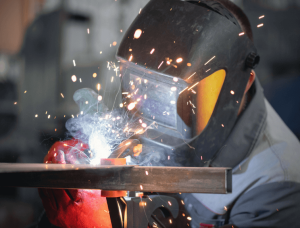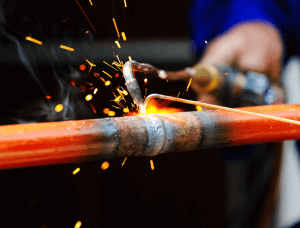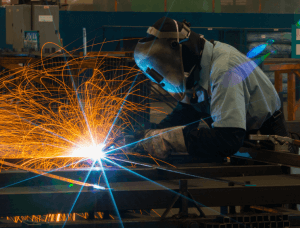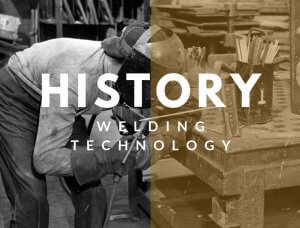Welding
Helpful Information About Potential Welding Careers
-

How to Become a More Efficient Welder
Whether you’re an experienced welder or just graduated from welding training, there are standard welding practices every welder should follow. Along with this, welders should be aware of common mistakes across the industry. Read more about some of the most common welding mistakes within the industry and how you can avoid them in the future.Lack of Preparation
Lack of preparation in any industry is unprofessional and should not be taken lightly when prepping to weld. Thoroughly preparing the metal you will be welding to remove any paint, rust, dirt, and other foreign substances is vital in ensuring the surfaces are clean. Failure to do so could lead to a weak weld on the pieces of metal. Cleaning isn’t the only major thing you should prep for before welding. Knowing the type of metal and its measurements is important in knowing how to weld the pieces together and if they will need multiple passes. Knowing the measurements of the specific metal types you are welding and adequately cleaning them will help you better prepare before welding. This knowledge will also help you determine a plan of action for how to execute the welds. Many of the other common welding mistakes stem from a lack of preparation.Safety Precautions
Safety is the top priority in welding and almost every occupation today. Working with flammable gases, sharp metal, debris, and a torch daily presents welders with a lot of liability. Making sure you know the proper safety precautions before diving into a weld can prevent accidents and even be lifesaving. To begin with, some of the most common precautions are personal protective equipment (PPE) pieces. These include work boots (preferably steel-toe), hearing protection, welding shield/helmet, and safety glasses. Ensuring you have the basic safety requirements is always an easy place to start when taking proper safety precautions. Your preparation before welding will help with safety too! Since you have prepared for what you are welding, you will know the appropriate types of welds needed for the job. Preparation goes a lot farther than just knowing what you will be welding.Wire and Electrode Selection
Before welding, it is essential to choose the correct wiring and electrodes needed for the job. This is regardless of the type of welding you will be doing (the three most popular are stick, flux-core, and MIG). Electrodes and wires are suited for different welding applications and need specific types to be effective. Knowing which types work with the different welds you are performing can save you from re-doing any wrong ones.Interpass and Preheat Temperatures
Like many common appliances and machinery, welding machines must be preheated before using them. Failure to preheat your machine and the metal area surrounding the weld to the proper temperature before conducting the weld can lead to problems and create more work for yourself. Proper preheating leads to fewer cracks and helps prevent future issues with the weld. Choosing the correct interpass temperature will help to solidify and correctly conduct your weld between the metals. Knowing what temperature is needed for the thickness and type of metal you are welding will help your weld and your preparation. Having correct preheat and interpass temperatures can save you from having to re-do a weld and other headaches that may result. Proper welding training can be a huge step in becoming a successful welder and avoiding these common welding mistakes. You will learn the proper preparation and techniques to weld various metals correctly. Qualified students can apply for tuition assistance programs and work with our job placement team to find openings with local and national employers! Get started in your welding career today! Call our admissions team at 866-951-4821 to learn more about enrolling with ACI! -

Is Welding the Right Career for You?
Welding is exciting. There’s nothing quite as exhilarating as powering on your torch and watching the sparks fly ablaze while you meld together whatever material is in front of you. Eventually, the individual pieces of metal you began with are now a single product, conceived by the influence of your own hands. It’s surely a satisfying process to complete; there’s no wonder why many seek to turn the craft into a professional career. With proper training, anyone can pick up the skills needed to do just that. But how do you know if the trade is the right fit for you? What makes a good welder? Here are a few insights into what it takes to find success in welding.Welding Might Be the Career for you if…
- You prefer physical work over sitting at a desk: Welding is a hands-on craft that is very much about physical labor. There’s a good chance you’ll never get to sit back in a cushy desk chair while on the job.
- You don’t want to attend college or university but still want a fulfilling career: A 4-year college degree isn't usually a requirement for finding success in welding. Additionally, welding certifications tend to be more affordable and quicker to complete. You can finish ACI’s Advanced Welding Course in just 38 weeks!
- Job sustainability is important to you: Welding jobs are always in demand. In fact, the manufacturing of more than 50% of U.S. products involves welding. This line of work is unlikely to go away any time soon, so professionals can remain confident in their ability to find their next project.
- An outdoor work environment appeals to you: Many jobs will require working in outdoor conditions. Hence, you should be sure you can handle the sun and fresh air all day if you’re considering this profession.
- You are interested in different industries: There are various opportunities for those who complete their welding training. A few industries you could work in include Construction, Automotive, Electric, Aerospace, Agriculture, Manufacturing, and many others.
- You like to travel: Welders are sought after all around the world. Furthermore, welding practices stay fairly consistent across borders, so travel enthusiasts can easily take on stints while on the go.
- You don’t mind working for long periods: Oftentimes, projects can keep you on your feet for hours at a time. Both mental and physical endurance is important for welders to perform at their best.
Characteristics of a Successful Welder
Anyone can become a professional welder with the right training and work ethic, but some traits can help aspiring tradespeople get farther ahead in their field:- Detail-oriented
- Self-motivated
- Knowledgeable in a variety of skills
- Has a solid understanding of the tools and equipment used on the job
- Keeps up to date on the latest industry news
- Puts safety first
- Capable of problem-solving
- Knows how to read blueprints and understands the role of welding in a project
- Understands the math and science behind their craft
- Has good interpersonal skills
If you are ready to start your welding career, contact us today!
-

Why Welding Safety is Crucial
In the welding industry, it is crucial for the safety of everyone to know what the potential hazards are. Yes, accidents happen, but with proper training and precautions, injuries can be avoided. Every welding job has different duties, however, they all can face the same risks if not cautious.Shop Safety: Common Risks
Welding can be a dangerous occupation when safety guidelines are not followed. If safety measures are ignored, welders can face a variety of hazards. The most common hazards that a welder can face are:- Electric Shock - When using an arc welder, a welder is at the most significant risk of electric shock. This commonly happens when a welder touches metal that has high voltage. Electric shock is the most serious hazard posed by welding and can result in burns, internal damage, cardiac arrest, or in some cases death.
- Fumes and Gases - The welding process releases a variety of toxic fumes and gases. These can range from arsenic, manganese, lead, nitrogen, carbon dioxide, and even carbon monoxide. When a welder is exposed to fumes and gases the health risks include impaired speech and movement, respiratory issues, and the possibility of cancer.
- Fire - Welding produces extreme temperatures and sparks. If a work area is not cleared correctly, it can cause fires and explosions.
- Physical Injuries - When welding, there are serval physical risks that everyone should be aware of. These include eye damage, cuts, burns, and crushed limbs. As a result, all welders are expected to wear the proper equipment on the job.
How to Avoid Workplace Risks
To avoid the mentioned risks and prevent further risks, follow these 6 tips.-
Wear the correct Personal Protective Equipment (PPE)
- Eye and Face Protection: Includes safety glasses and face shields. If the job requires, welders could also have to include a helmet.
- Fume and Gas Protection: Respirators and fume extraction systems protect welders when proper site ventilation is not enough.
- Heat and Radiation Protection: The heat put off from welding makes wearing a heat-resistant outer layer, gloves that extend up the forearm, welding hoods, and goggles vital to a welder’s protection.
- Electric Shock Protection: The previous protection equipment also helps with electric shocks when paired with insulated under layers and boots with rubber soles.
- Ear Protection: When a welder is in an area where the sound is over 85dB for an extended period, ear protection is needed.
-
Precautions from Fumes and Gases
-
Take Precautions Against Electrocution
-
Check Equipment
-
Know the Environment
-
Keep Learning
-

School is back in session for you too!
It's back to school time for families across the country and it can be back to school for you too! There is no better time to hit the books again. While your kids are trying to move on to the next grade level, you will be moving on to your next career! At Advanced Career Institute (ACI), you can take the first step to a new career in trucking or welding. Still not sure? Check out our list of great reasons to start your training today!- Short Training Time - At ACI, our goal is to get you trained and out in the workforce in a time frame that gets you earning the money you deserve quickly. If you go back to school with ACI, you'll be off to the workforce in 4 weeks for trucking and 38 weeks for welding.
- Job Placement- Going back to school can be scary because of the uncertainty of career placement once you graduate. However, ACI takes care of this worry for you! ACI offers job placement assistance that includes helping your job search, practice for interviews, and spruce up your resume.
- Jobs In Demand - Currently, the trucking industry is one of the most in-demand career paths on the market today. This means jobs are just around the corner for you once your training is complete. Additionally, as a new school year starts, opportunities for school bus drivers will also emerge.
- Tuition Assitance Available - If you go back to school with ACI, you have the possibility to be eligible for financial aid assistance. This assistance can help pay for your training and possibly take away the stress of tuition for you and your family.
- Inspire Your Children- Children look up to and admire their parents. If they see mom and dad are working hard in school, it can encourage your children to do their best in school too! This can turn into wonderful bonding time.
-

Understanding Welding and its Beginning
Welding is an ancient trade. Our earliest known welded artifacts are gold boxes dating back to the Bronze Age, according to a publication by Miller Welds. Little changed for the trade for nearly two thousand years. From the skilled efforts of respected Viking blacksmiths who forged weapons and shod horses for their raiding trips, until the late eighteenth century, welding technology remained largely static. We didn't see significant changes in the trade until the early 1800s. Worldwide efforts and advancements during those few centuries changed the process swiftly.The 1800s: Patents and Technology
Major developments in welding technology began in England. There, Edmund Davy discovered acetylene (C2H2) in 1836. Acetylene is a colorless gas used for both welding and metal cutting. The electric generator was an important part of machinery invented mid-century, and arc lighting became the popular method among welders. Gas welders and cutters were developed later in the century as well. Finally, arc welding with the carbon arc and metal arc was developed. Resistance welding (the joining of metals by applying pressure and passing electrical current) became the practical process. Carbon arc welding remained the popular welding method through the early 1900s. Meanwhile, in Detroit, C.L. Coffin was awarded the first U.S. patent for an arc welding process.The Early 1900s: WWI & WW2
During the early 1900s, resistance welding processes were being developed such as seam welding, spot welding, and flash butt welding. Each process required tradesmen to garner new skills and technique. With these new skills came new opportunities, particularly for the military. The onset of World War I brought tremendous demand for weapons and armament. Welders were pressed into work as a commodity to take care of general machinery and ships. According to Welding History, the first all-welded hull vessel was the HMS Fulagar, of Great Britain. They go on to state, "because of a gas shortage in England during World War I, the use of electric arc welding to manufacture bombs, mines, and torpedoes became the primary fabrication method." Welders became highly prized tradesmen among the armed forces. In 1919, the American Welding Society was founded by 20 members of the Wartime Welding Committee of the Emergency Fleet Corporation, under the leadership of Comfort Avery Adams. That same year alternating current was invented. Stud welding was developed at the New York Navy Yard in 1930. This method quickly became popular among shipyards and construction sites. This method of welding still remains popular today. Around this time the submerged arc welding process took hold. It was developed by the National Tube Company and was designed to make the longitudinal seams in pipes, for a pipe yard in Pennsylvania. In the 1940s Gas Tungsten Arc Welding (GTAW) "was found to be useful for welding magnesium in fighter planes, and later found it could weld stainless steel and aluminum," buy Welding History. They go on to say, "the invention of GTAW was probably the most significant welding process developed specifically for the aircraft industry and remained so until recently, with the Friction Sir Weld process of the 1990s." Again, welders found themselves highly prized with the military. In 1948, The Ohio State University Board of Trustees established the Department of Welding Engineering as the first of its kind for a Welding Engineering curriculum at a University.Today:
Laser welding would be welding's most recent advancement. Laser beam welding "is mainly used for joining components that need to be joined with high welding speeds, thin and small weld seams and low thermal distortion. The high welding speeds, an excellent automatic operation, and the possibility to control the quality online during the process, make laser welding a common joining method in the modern industrial production," according to Rofin. Laser welding is especially appropriate for modern delicate work, with applications in aerospace and IT. Welding has come a long way since the Bronze Ages. These highly skilled tradesmen and women are in great demand during both in the past and present. Exciting new advancements like laser welding keep the industry both exciting and relevant. To learn more about welding training, contact Advanced Career Institute. -

What's Your Best Option for Welding Training
Career Training or Community College? Which is the right choice for you? These are big questions and can determine your career path. Let's go over the main points of each.Career Training (such as Welding School)
- Goal: To earn a certificate, diploma, the opportunity to take a licensing exam or an apprenticeship/work as a journeyman
- Training is specific to the career path, no general education courses required
- Focused on hands-on learning
- Smaller class sizes
- Up to date with current field technology
- Most trade school certificates can be obtained in under 2 years
- Over 50% can be held in under 12 months
- Trade school costs about ¼ the average 4-year degree
Community College
- Goal: To earn an associate degree, possibly transfer to a 4-year university
- More educational preparation required
- General education coursework required (Math, English, History, Science, etc)
- Mostly classroom or lecture classes, possibly some hands-on depending on the field
- Usually compatible with a 4-year degree program
- Minimum time to complete: 2 years
- Community College costs less than half the average 4-year degree
Selecting Your Best Option
To summarize, a trade school, like welding, is for someone who is sure of their desired career path. They also learn best by doing and wanting to join the workforce quickly. On the other hand, a community college is ideal for someone who wants to try out several different fields before choosing one. This person also needs to be good at learning in a classroom setting and should be able to devote 2 years to education. You may wonder what kind of salary you can look forward to with each of these options. While it is true that someone with a bachelor's degree will generally, throughout their lifetime, out-earn someone with a trade certificate, it really matters more what career path you want to follow. Certain professions will be served better by earning a 2- or 4-year degree, while others are best suited to a trade school education. When you're ready to discuss your next career steps, contact Advanced Career Institute. We'd be happy to help you decide if our courses are your perfect fit. Contact us today to learn more about our Welding and CDL training!


 All
All Trucking
Trucking Welding
Welding From the Experts
From the Experts